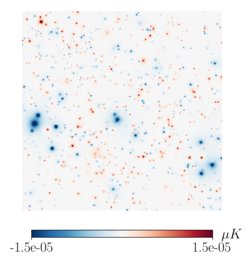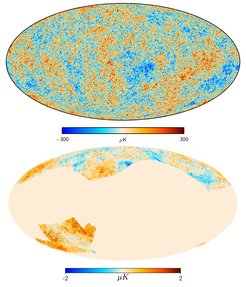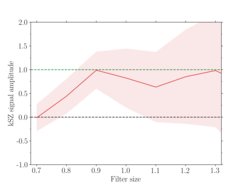Optimal measurements of the kinematic Sunyaev-Zel'dovich effect reveal missing matter
Where are the baryons? This question naturally arises as the predicted abundance of baryons in the universe - the basic building blocks of all elements in the periodic table – do not agree with observations of the intergalactic medium. Locating the missing baryons will help us to not only better understand the formation and evolution of galaxies, but also to better constrain possible extensions of the current standard model of cosmology. MPA researchers have turned to a novel approach in modelling the galaxy distribution to optimize measurements of the kinematic Sunyaev-Zel'dovich effect, an emerging tool to probe the distribution of baryons in galaxy clusters.

Before arriving at our satellites and telescopes, the cosmic microwave background (CMB) radiation, the most ancient light of our Universe, often passes through clusters of galaxies, the largest gravitationally bound structures ever observed. These massive objects are so hot that their gas is completely ionized. As a first approximation, the CMB photons "feel" the structures through their Thomson scatterings with free electrons residing inside the clusters. These scatterings induce a secondary temperature anisotropy (Fig. 1) onto the observed CMB temperature anisotropy map. This effect was, in fact, first predicted by MPA director Rashid Sunyaev together with Yakov Zel'dovich, hence the name kinematic Sunyaev-Zel'dovich (kSZ) effect.
With the advent of CMB experiments that offer unprecedented sensitivities, e.g. Simons Observatory and CMB-S4, the kSZ effect is a raising candidate to hunt down the missing baryons. The key to a precise, unbiased inference of the baryonic abundance through the kSZ signal is information from the bulk flow of matter on very large scales, which is unfortunately not available from CMB data alone.
Until now, measurements of the kSZ effect have assumed a greatly simplified scheme of large-scale bulk-flows using information on the distribution of galaxies, as mapped by spectroscopic (redshift) surveys. Further, this approach often completely ignores uncertainties from reconstructing the velocity information from galaxy measurements when trying to infer the baryonic abundance and distribution.

Top: CMB temperature anisotropies, as mapped by ESA’s Planck satellite.
Bottom: Example prediction of the kSZ signal from the large-scale matter and velocity reconstruction using the Bayesian forward modelling approach. Since the reconstruction relies on some input galaxy data, the kSZ signal is only predicted for the sky regions where these galaxies were observed. Note the large difference between the typical amplitude of the observed CMB anisotropies and that of the kSZ signal (scale bars at the bottom of the images).Recently, researchers at MPA have made a significant step forward: introducing an original inference scheme in which all uncertainties in the reconstructed large-scale motion are accounted for. By doing so, they also unveil that this often-ignored source of systematics can significantly bias the inferred amount of baryons.
The crucial novelty is the use of an innovative framework leveraging modern computational power: Bayesian forward modelling of galaxy clustering. In essence, this approach models the entire three-dimensional matter and velocity fields, constrained by galaxy data. The result is not one, but many possible realizations of matter and velocity fields, all physically plausible given the observational galaxy data. This ensemble of velocity realizations allow MPA researchers to re-formulate the inference problem, accounting for all velocity uncertainties, which are induced by imperfect galaxy observations.
The MPA researchers and their European colleagues have rigorously tested and carefully applied this innovative method onto a CMB temperature map observed by the Planck satellite, a space observatory operated by the European Space Agency. In particular, they looked at locations where massive galaxy clusters have been identified by the Sloan Digital Sky Survey (SDSS) (Fig. 2). The secondary anisotropies expected from the kSZ signal is about 100 times smaller than the fluctuations in the original CMB data. Searching for the kSZ signal is thus pretty much like looking for a needle in a haystack.

Nevertheless, the team find evidence for the kinematic Sunyaev-Zel'dovich effect and the missing baryons (Fig. 3). A kSZ signal was observed at the expected amplitude, although it is not surprising that the evidence is not yet conclusive - only at roughly 2.3 sigma, or with 99 percent confidence level. This measurement has the most rigorous error bar up-to-date, taking into account uncertainties from the velocity reconstruction process.
The algorithm presented by MPA researchers is easily scalable and readily applicable on upcoming datasets. The future goal is clear: to unblock the full potential of kinetic and thermal SZ measurements in probing not only missing baryons but also the nature of inflation and Dark Energy - two long-standing puzzles about the early and late time universe.














